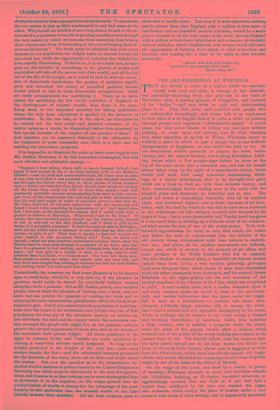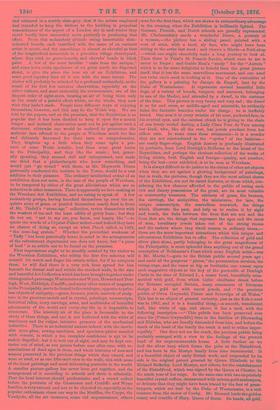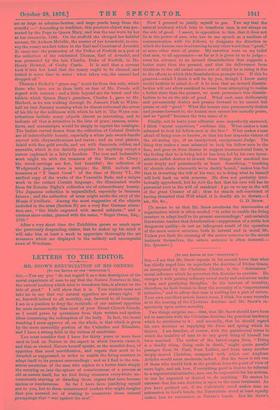THE ART-EXHIBITION AT WREXHAM. THAT Art should 8C nicker in
a region which we associate chiefly with coal and slate, is strange in the abstract, but especially surprising when one gets out of the train at Wrexham—after a passing glimpse of Llangollen, and memory of its "ladies "—and sees what an ugly and uninteresting place it is. Flat, dull, dirty, and crowded with people who are unbeautiful exceedingly, and whose talk is so unpleasant to hear when it is in English that it is quite a relief, on pushing through groups who represent " obstruction's apathy" in a new sense, for they never dream of letting any one pass without pushing, to come upon real natives, who do their swearing and other amenities of speech in Welsh, Wrexham seems as unlikely a place in which to pass a happy day, in any aesthetic interpretation of happiness, as one could not wish to see. As the despondent visitor proceeds to inspect the town, before turning into the narrow-fronted, raw-looking Exhibition build- ing, before which a few meagre flags flutter, he turns at the top of the main street into a narrower one, and has his breath almost taken away by the sight of a magnificent church, which stands well back, with many venerable surrounding dwell- ings, in a dreary churchyard, shut in by wrought-iron gates which are a treat to look at, with their delicate tracery, and their serrated-edged leaves curling over at the ends with the mingled grace and sharpness so beautiful and so rare. The grand old tower is exceedingly beautiful, with all its notched edges, and mutilated figures—one of them, the saint of its invo- cation, with the hind by which he was said to have been nurtured in the wilderness—its soft outlines, touched into dimness by the finger of time ; but a more destructive and Vandal hand has given it a one-eyed look, by sticking up a hideous clock of the common- est kind across the face of one of the mural arches. With well- founded apprehension for what he may find inside, the visitor may follow the mob of excursionists into the interior of the old church, whose whitewashed walls bear witness to destruc- tion too ; and where all the modern monuments are hideous, except one, which is erected to the memory of an officer and some privates of the Welsh Fusiliers who fell in Ashanti One fine window of stained glass, a beautiful old brazen lectern (which dates from 1544), a very curious, grinning, grotesque head near the great door, which seems to have been overlooked when the other ornaments were destroyed, and the arms of Queen Elizabeth on the organ-gallery, are .,the sole remnants of the ancient grandeur of the Church of St. Giles, which was completed in 1472. A very secular table, with a leaden inkstand upon it and some common chairs set round it, close to the sanctuary- rails, and certain indications that the space under the organ- loft is used as a schoolroom— a massive oak chest, iron- clamped, evidently many centuries old, is among the furni- ture—lend a curious and not agreeable incongruity to the scene. There is nothing else to observe in the town except a bloated and brawling hunchback, of herculean build, who bestrides a large donkey, and is making a progress down the street, amid the grins of the gaping crowd, after a fashion which reminds one of the prints of the merry-making processions in the coarser times of old. The brutish fellow, with his unshorn face, his splay hands spread out on his huge knees—the bridle lies loose on the neck of the donkey, whose pace is suggested by kicks from the rider's heels, which meet beneath the animal—his baggy cheeks and mouth distended for coarse speech and rough laughter, might be one of the train of the Abbot of Misrule.
On the verge of the town, and hard by a cluster of places of worship—Wrexham abounds in sects and churches—stands the Exhibition building, an ill-shapen, lop-sided structure, so aggravatingly crooked that one feels as if one had had a squint from childhood by the time one reaches the organ and orchestra, which occupy the place of honour under a roof covered with strips of dirty awning, and so ingeniously decorated and coloured in a muddy slate-grey, that if the artists employed had intended to keep the visitors to the building in perpetual remembrance of the aspect of a London sky in mid-winter they could hardly have succeeded more perfectly in producing that effect. From this melancholy altitude swing lamentable slate- coloured boards, each inscribed with the name of an eminent artist in music, and the assemblage is almost as cheerful as that of the longitudinal memorials in a primitive village churchyard, where they stick to grave-boards, and cherubs' heads in black paint. A few of the most familiar " casts from the antique," and some terra-cotta specimens of no great merit, are dispersed
about, to give the place the true air of an Exhibition, and
some good tapestry does all it can with the same intent. The visitor will probably be attacked by a profound melancholy, as the result of his first few minutes' observation, especially as the other visitors, and most noticeably the excursionists, are of the limpest order of sight-seers, wearing an air of being there only as the result of a painful effort which, on the whole, they now wish they hadn't made. People have different ways of enjoying themselves, however, and this may be the Welsh way. We are told by the papers, and on the premises, that the Exhibition is so popular that it has been decided to keep it open for a month longer ; and isolated observation must not be put against such a statement, otherwise one would be inclined to pronounce the aesthetic fare offered to the people at Wrexham much too fine and delicately flavoured for their taste or comprehension. They brighten up a little when they come upon a por- trait of some Welsh notable, lent from some great house in the Principality, and they like the music ; but, gener- ally speaking, they seemed dull and unimpressed, and made one think that a philanthropist who knew something, and would just "go round" with them, as Mr. Hepworth Dixon personally conducted the tourists to the Tower, would be a vast addition to their pleasure. The ordinary intellectual ordeal of an exhibition does not seem, in the case of the people of Wrexham, to be tempered by either of the great alleviations which are so seductive in other instances. There is apparently no love-making at the Wrexham Art Exhibition, and no eating to speak of. A few melancholy groups, having knocked themselves up over the ex- quisite array of gems, or puzzled themselves nearly dead in front of Mr. Tindall's "stone-age" collection, revive themselves with the weakest of tea and the least edible of gritty buns ; but they do not eat, " not to say eat, you know, not hearty like "—to quote the words of a Crystal-Palace waiter—and indeed they have no chance of doing so, except on what Punch called, in 1862, "the nose-bag system." Whether the proverbial weakness of " Taffy " has been practically borne in mind in the arrangements of the refreshment department one does not know, but "a piece of beef " is an article not to be found on the premises.
First impressions ought to be steadily resisted by the visitor to the Wrexham Exhibition, who within the first five minutes will consult his watch and finger his return-ticket, for if he conquers them, he will find there is a very rich feast spread for- him beneath the dismal roof and within the crooked walls, in the rare
and beautiful Art Collection which has been brought together under distinguished patronage. Westminster and Wynn, Howard and Den- bigh, West, Biddulph, Cunliffe, and many other names of magnates in the Principality, are to be found in the catalogue, opposite to price- less objects of antiquity,—gems, bronzes, jewels, marvels of sculp- ture in the precious metals and in crystal, paintings, manuscripts, historical relics, ivory carvings, arms, and multitudes of beautiful adornments of the world and every-day life in it impossible to enumerate. The leisurely air of the place is favourable to the study of these things, and one is not bothered with the whirr of machinery and the vulgar, intrusive presence of the mechanical industries. There is an industrial annexe indeed, with the inevit- able spun-glass, sewing-machines, and specimen-plates mended with cement, in which a too complete confidence is apt to be rudely dispelled ; but it is well out of sight, and may be kept cen- turies out of mind, as one pauses before case after case, with re- suscitations of dead ages in them, and whole histories of men and women preserved in the precious things which they owned, and wore or used, or as one lifts one's eyes to the walls, rich with some of the finest paintings and most interesting portraits in the world. A statelier picture-gallery has never been got together, and the arrangement of it according to schools and dates is admirable. That the local interest should predominate, and a crowd collect before the portraits of the Grosvenor and Cunliffe and Wynn families, is verynatural, and not to be objected to, especially as the popular enthusiasm clears our way to the Murillos, the Cuyps, the Vandycks, all the art treasures, some old acquaintances, others seen for the first time, which are shown to extraordinary advantage in the evening, when the Exhibition is brilliantly lighted. The German, Flemish, and Dutch schools are grandly represented. Mr. Cholmondeley sends a wonderful Diirer, a portrait of a woman,—the picture has a sliding panel, painted with a coat of arms, with a hard, sly face, who might have been sitting to the artist last week ; and there's a Mieris—a fruit-shop —which one might cheerfully make a long journey to look at. Then there is Viani's St. Francis Xavier, which once to see is never to forget ; and Guido Reni's " study " for the " Aurora " which is so far more delightful to behold than the great picture itself, that it has the same marvellous movement, and one need not twist one's neck in looking at it. One of the curiosities of the gallery is a painting by Jacopo da Empoli, lent by the Duke of Westminster. It represents several beautiful little dogs, of a variety of breeds, tempers, and manners, belonging to one of the Medici, and attended by a dwarf, in the costume of the time. This picture is very funny and very sad ; the dwarf is so fat and cross, so middle-aged and miserable, he evidently hates the fantastic beauties under his charge ; he is ineffably bored. One sees it in every wrinkle of his sour, puckered face, in his averted eyes, and the careless chuck he is giving to the chain of one lovely curled darling, a Lady Clara Vere de Vere among her kind, who, like all the rest, has jewels pendant from her silken ears. In some cases these ornaments—it is a wonder they are not reintroduced in the " cycles " of the fashions— are costly finger-rings. English history is profusely illustrated by portraits, from Lord Denbigh's Holbeins to the latest of the. Reynoldses, and perhaps the choicest collection of the works of living artists, both English and foreign—quality, not number, being the test—ever exhibited, is to be seen at Wrexham.
It is always difficult to do justice to the claims of other art objects when they are set against a glowing background of paintings, but in truth, the pictures, though they are the most salient charm of the Exhibition, are not its rarest features, or those which, con- sidering the few chances afforded to the public of seeing such rich and dainty possessions of the great, are its most valuable or noteworthy treasures. The cabinets of gems, the bronzes, the carvings, the antiquities, the miniatures, the lace, the unique manuscripts, the marvellous ironwork, the things which illustrate the past, and help us to realise it by sight and touch, the links between the lives that are not and the lives that are, the things that represent the ages and the races of men, hereditary jewels taken out of the strong rooms and the caskets where they dwell unseen in ordinary times,— these are the more important attractions which this unique and adventurous Exhibition has to offer. The collection of gold and silver plate alone, partly belonging to the great magnificoes of the Principality, is more splendid than anything out of the grand conception of Belshazzar's Feast which some English artist—was it Mr. Martin ?—gave to the British public several years ago ; and amid all the gorgeous " pieces," the presentation services, the racing-cups, and the vases as big as footbaths, one comes upon such suggestive objects as the key of the portcullis of Denbigh Castle in the time of Edward I., a mazer bowl, beautifully orna- mented with gold, from which Celtic chieftains drank before the Romans occupied Britain, many ornaments of Etruscan design in gold set with uncut jewels, and " the precious pebble of Owen Gwynedd, Prince and Sovereign of all Wales." This last is an object of general curiosity, just as the Koh-i-noor was in 1862, and it is a beautiful thing,—a smooth, translucent ball, like white of egg, and above it lies a card, with the following inscription :—" This pebble has been preserved ever since his [Prince Gwynedd's] time in the families of. Rhewaedog and Rhiwlas, who are lineally descended from him, and before the death of the head of the family the crack is said to widen imper- ceptibly." One does not see the crack, the precious pebble being probably arranged with a view to the feelings of the present head of the unpronounceable house. A little further on we find the silver harp which forms the prize at the Elsteddvod, and has been in the Mostyn family from time immemorial. It is a beautiful object of early British work, and suspended by its side is the original patent granted by Queen Elizabeth to Sir Richard Bulkeley, Lord Mostyn, and others, for the establishment of the Eisteddvod, which was signed by the Queen at Chester, in the ninth year of her reign. In the same case with two exquisitely beautiful crystal coffers, damascened with minute gold arabesques, so delicate that they might have been traced by the feet of grass- hoppers, which are lent by the Duke of Westminster, is a rich treasure from the stores of Corby. Mr. Howard lends the golden rosary and crucifix of Mary, Queen of Scots. Its beads, all gold, are as large as arbutus-berries, and large pearls hang from the crucifix :—" According to tradition, this precious object was pre- sented by the Pope to Queen Mary, and was the one worn by her at her execution, 1586. On the scaffold she charged her faithful servant, Sir Andrew Melville, the master of her household, to con- vey the rosary as a last token to the Earl and Countess of ArundeL It came into the possession of the Dukes of Norfolk as a part of the collection of the celebrated Thomas, Earl of Arundel, and was presented by the late Charles, Duke of Norfolk, to Mr. Henry Howard, of Corby Castle. It is said that a servant took it into her head that the rosary ought to be cleaned, and boiled it some time in water ; when taken out, the enamel had dropped off."
Thomas it Becket's "grace-cup" is not far from this relic, which those who have not in them faith or fear of Mr. Froude will regard with interest ; and a little beyond are the watch and the tablets which Queen Mary's grandson, Charles I., gave to Mr. Herbert, as he was walking through St. James's Park to White- hall on that January morning when be almost redeemed the errors of his life by-the nobleness with which he left it. The Wynn con- tributions include many objects almost as interesting, and to indicate all that is attractive in the lists of gems, cameos, minia- tures, and manuscripts would be simply to reprint the catalogue. The Indian carved stones from the collection of Colonel Guthrie are of indescribable beauty, especially a white jade sword-handle carved with chrysanthemums and leaves ; and an oval plateau, inlaid with fine gold scrolls, and set with diamonds, rubies, and emeralds, which is too daintily exquisite for anything except a corner cupboard in a fairy's boudoir. The iron and locksmith's work might vie with the treasures of the Muge de Cluny ; the wood-carvings are few, but beautiful ; the collection of Wedgwood's jasper ware is unique; the MSS. include such treasures as " Y Sanet Greal " of the time of Henry VI., the earliest copy of the works of the Venerable Bede, and a unique work in the extinct Cornish language ; the illuminated works from Sir Kenelm Digby's collection are of extraordinary beauty. The Japanese collection is unparallelled, especially in Satsuma faience ; and the collection of arms might excite the envy of the Muses d'Artillerie. Among the most suggestive of the objects included in the arms (Section N) are a very fine German execu- tion-axe, " the blade engraved with sacred subjects ;" and a curious slave-collar, pierced with the name, " Roger Owen, Esq., 1705."
After a very short time the Exhibition grows so much upon the previously desponding visitor, that he makes up his mind it will take him at least a week to appreciate thoroughly the art treasures which are displayed in the unlikely and uncongenial town of Wrexham.




































 Previous page
Previous page